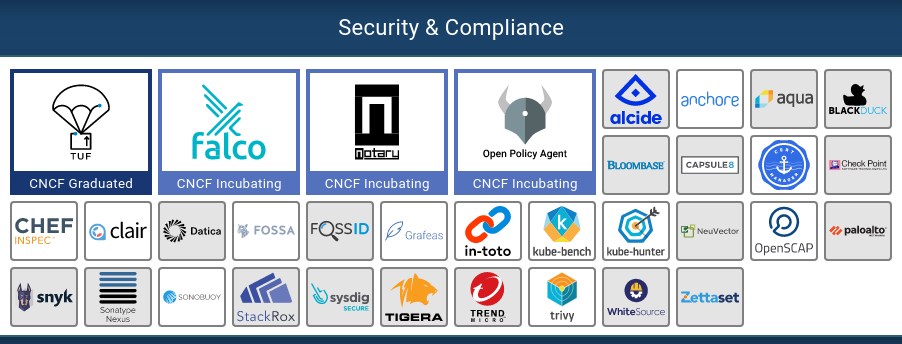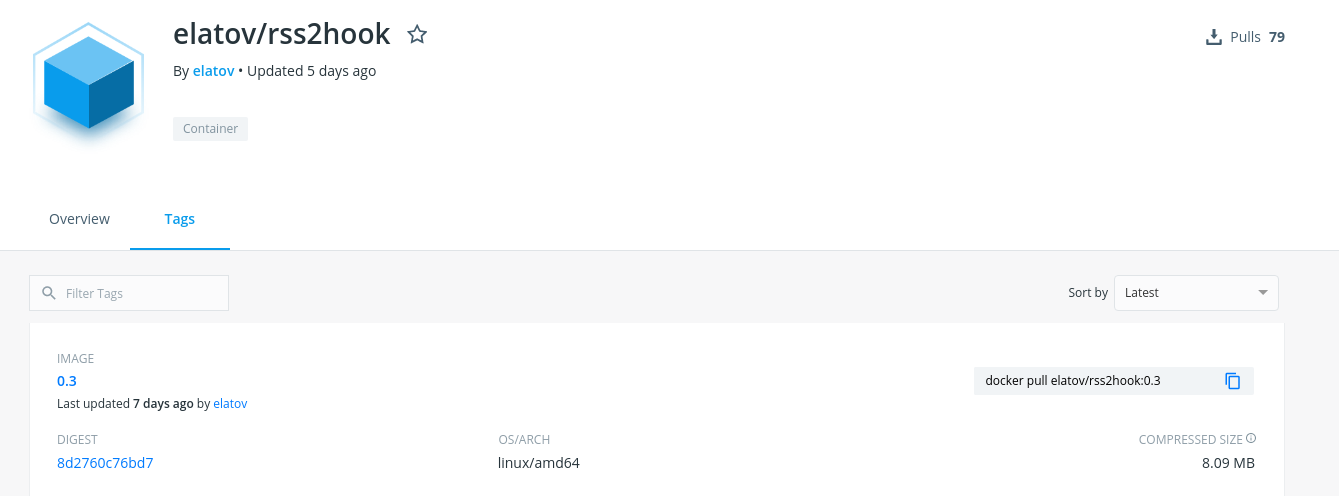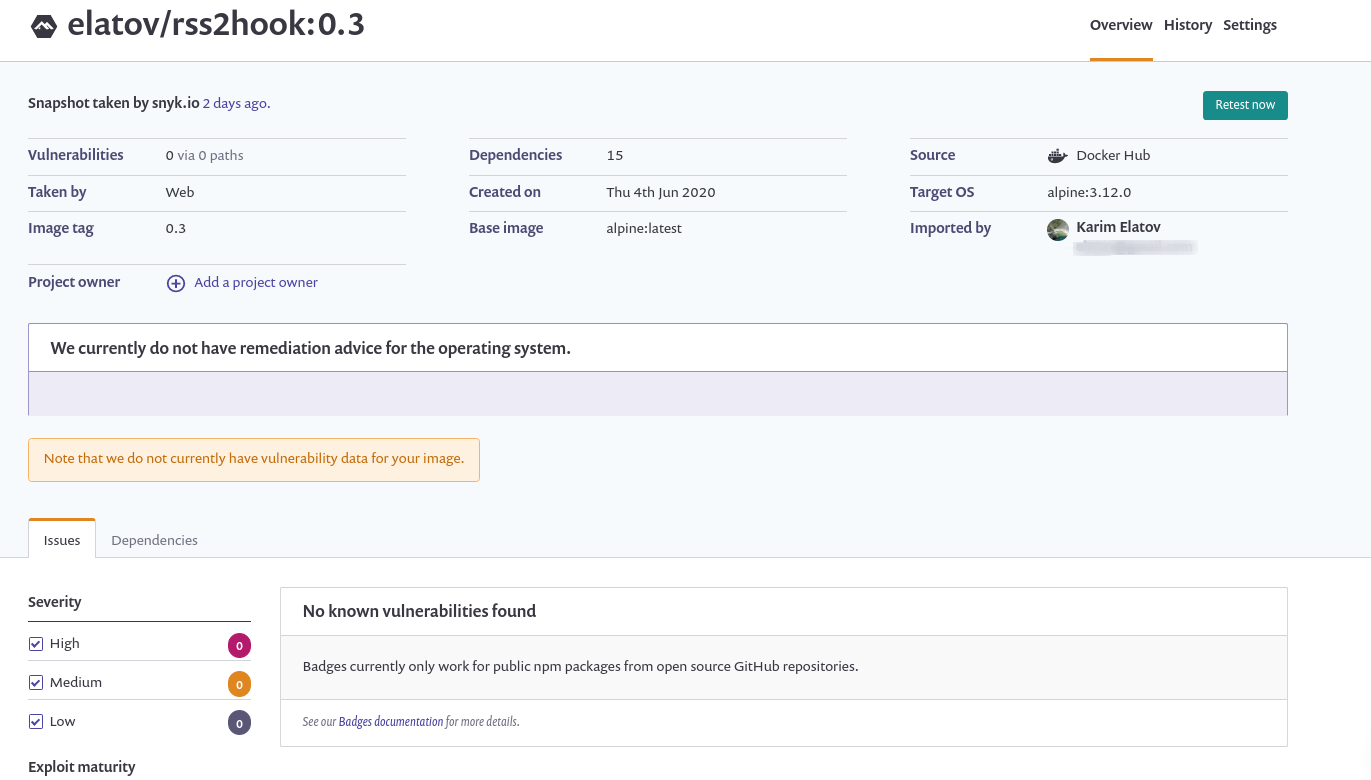Trying Out Some Security Tools for Kubernetes
Looking over the CNCF landscape Security & Compliance section there are a bunch of tools out there:

So I decided to try out a few:
- falco
-
From their page:
Falco parses Linux system calls from the kernel at runtime, and asserts the stream against a powerful rules engine.
-
- trivy
-
From their github page:
A Simple and Comprehensive Vulnerability Scanner for Containers, Suitable for CI.
-
- Snyk
-
They have a bunch of products, but I concentrated on the container vulnerabilities features. From their page:
Detecting vulnerabilities in containers and Kubernetes applications throughout the SDLC
-
Installing and Using Falco
Falco is a runtime security engine. I used to use ossec and this reminds me of that software but container centric. To install it, we can use a helm chart:
> git clone https://github.com/falcosecurity/charts
> helm template \
--set ebpf.enabled=true \
--set falco.jsonOutput=true \
--set falco.jsonIncludeOutputProperty=true \
--set falco.programOutput.enabled=true \
--set falco.programOutput.program=""jq '{text: .output}' | curl -d @- -X POST https://hooks.slack.com/services/see_your_slack_team/apps_settings_for/a_webhook_url \
charts/falco
It creates a daemonset and compiles a kernel module on each node. If you check out the logs when the daemonset is starting up you will see something like this:
> k logs -f falco-7gcdl
* Setting up /usr/src links from host
* Running falco-driver-loader with: driver=bpf, compile=yes, download=yes
* Mounting debugfs
* Found kernel config at /host/boot/config-5.4.0-33-generic
* Trying to compile the eBPF probe (falco_ubuntu-generic_5.4.0-33-generic_37.o)
In file included from /usr/src/falco-96bd9bc560f67742738eb7255aeb4d03046b8045/bpf/probe.c:13:
In file included from ./include/linux/sched.h:14:
...
...
5 warnings generated.
* Skipping download, eBPF probe is already present in /root/.falco/falco_ubuntu-generic_5.4.0-33-generic_37.o
* eBPF probe located in /root/.falco/falco_ubuntu-generic_5.4.0-33-generic_37.o
* Success: eBPF probe symlinked to /root/.falco/falco-bpf.o
Sat Jun 6 02:40:49 2020: Falco initialized with configuration file /etc/falco/falco.yaml
Sat Jun 6 02:40:49 2020: Loading rules from file /etc/falco/falco_rules.yaml:
Sat Jun 6 02:40:50 2020: Loading rules from file /etc/falco/falco_rules.local.yaml:
Sat Jun 6 02:40:55 2020: Starting internal webserver, listening on port 8765
Then as a quick test launch a container and open a shell to it:
> kubectl run -it --rm test --image busybox --restart Never --command -- /bin/sh
If you don't see a command prompt, try pressing enter.
/ #
And in your slack channel you will see a rule triggered:

If you want to modify the rules there is a way to append rules to add logic to ignore any false positives that may apply to your setup. The process is described in Appending to Rules. I ended up creating a configmap with the falco_rules.yaml and falco_rules.local.yaml files and updating them to fit my needs.
If you are so inclined you can also setup the falco-exporter to export events for scraping by prometheus.
Using Trivy
I was actually watching the Trivy Open Source Scanner for Container Images – Just Download and Run! CNCF webinar and I really like what it does and it’s upcoming features. I also enjoyed the results of Open Source CVE Scanner Round-Up: Clair vs Anchore vs Trivy web page. To run it manually and locally you can just install it on any Linux distro. On my ArchLinux machine I just ran the following to install it:
> yay -S aur/trivy
Then as a quick test we can run the following:
> trivy i quay.io/kubernetes-ingress-controller/nginx-ingress-controller:0.32.0
2020-06-05T23:02:30.128-0400 INFO Need to update DB
2020-06-05T23:02:30.128-0400 INFO Downloading DB...
16.42 MiB / 16.42 MiB [-----------] 100.00% 6.67 MiB p/s 3s
2020-06-05T23:02:33.798-0400 INFO Detecting Alpine vulnerabilities...
quay.io/kubernetes-ingress-controller/nginx-ingress-controller:0.32.0 (alpine 3.11.5)
=====================================================================================
Total: 2 (UNKNOWN: 1, LOW: 0, MEDIUM: 1, HIGH: 0, CRITICAL: 0)
+---------+------------------+----------+-------------------+---------------+--------------------------------+
| LIBRARY | VULNERABILITY ID | SEVERITY | INSTALLED VERSION | FIXED VERSION | TITLE |
+---------+------------------+----------+-------------------+---------------+--------------------------------+
| libxml2 | CVE-2019-20388 | MEDIUM | 2.9.10-r2 | 2.9.10-r3 | libxml2: memory leak |
| | | | | | in xmlSchemaPreRun in |
| | | | | | xmlschemas.c |
+---------+------------------+----------+-------------------+---------------+--------------------------------+
| nghttp2 | CVE-2020-11080 | UNKNOWN | 1.40.0-r0 | 1.40.0-r1 | In nghttp2 before version |
| | | | | | 1.41.0, the overly large |
| | | | | | HTTP/2 SETTINGS frame |
| | | | | | payload... |
+---------+------------------+----------+-------------------+---------------+--------------------------------+
They have a database which is updated every 12 hours and they scan from popular locations. From their vuln-list here are the sources they use to generate their database from:
Directory OS Source URL alpine/ Alpine Linux Alpine Linux Bug tracker https://bugs.alpinelinux.org/projects/alpine/issues amazon/1 Amazon Linux Amazon Linux Security Center https://alas.aws.amazon.com/ amazon/2 Amazon Linux 2 Amazon Linux Security Center https://alas.aws.amazon.com/alas2.html debian/ Debian GNU/Linux Security Bug Tracker https://security-tracker.debian.org/tracker/ nvd/ - National Vulnerability Database https://nvd.nist.gov/ oval/debian Debian GNU/Linux OVAL https://www.debian.org/security/oval/ redhat/ RHEL/CentOS Security Data https://www.redhat.com/security/data/metrics/ ubuntu/ Ubuntu Ubuntu CVE Tracker https://people.canonical.com/~ubuntu-security/cve/ cvrf/suse OpenSUSE/SLES SUSE Security CVRF http://ftp.suse.com/pub/projects/security/cvrf/ photon/ Photon Photon Security Advisory https://vmware.bintray.com/photon_cve_metadata/ ghsa/ - GitHub Advisory Database https://github.com/advisories/
I thought it was pretty useful. They also have examples of how to use it in your CI system, the process is described in [Continuous Integration (CI)](https://aquasecurity.github.io/trivy/latest/advanced/integrations/, you basically run something along the lines of this:
./trivy --exit-code 0 --severity HIGH --no-progress trivy-ci-test:${COMMIT}
./trivy --exit-code 1 --severity CRITICAL --no-progress trivy-ci-test:${COMMIT}
As part of your CI/CD and make a decision whether to stop the build or keep going based on how many vulnaribilities the image has.
Adding Trivy to a Tekton Pipeline
I decided to keep just informational and added a new task which I called from a couple of pipelines:
> cat tasks/trivy-scan.yaml
apiVersion: tekton.dev/v1beta1
kind: Task
metadata:
name: trivy-scan
spec:
workspaces:
- name: git-source
description: The git repo
params:
- name: msg-file
description: file to be used to send smack message
type: string
default: msg.txt
steps:
- name: trivy-scan-image
image: aquasec/trivy
script: |
#!/bin/sh
## Globals
GREP="/bin/grep"
AWK="/usr/bin/awk"
TRIVY="/usr/local/bin/trivy"
SOURCE=$(workspaces.git-source.path)
MSG="${SOURCE}/$(params.msg-file)"
IMAGES=$(${GREP} -h 'image:' ${SOURCE}/*.yaml | ${AWK} -F ' ' '{ print $2 }')
for image in ${IMAGES}; do
echo "*${image}*" >> ${MSG};
echo '```' >> ${MSG};
${TRIVY} -q image -o file.txt ${image} >> ${MSG};
echo '```' >> ${MSG};
done
# debug
cat ${MSG}
- name: send-mesg
image: curlimages/curl:7.68.0
script: |
#!/bin/sh
SED="/bin/sed"
CURL="/usr/bin/curl"
CAT="/bin/cat"
SOURCE=$(workspaces.git-source.path)
MSG_FILE="${SOURCE}/$(params.msg-file)"
MSG=$(${CAT} ${MSG_FILE})
${CURL} -s -X POST -H 'Content-type: application/json' --data '{"text":"'"${MSG}"'"}' $URL
env:
- name: URL
valueFrom:
secretKeyRef:
name: webhook-secret
key: url
And I would get a message in my slack channel with the results :) (check out previous post on how to use pipelines and how to share data between tasks in a pipelinerun… also as a side note check out this awesome post Speed up Maven builds in Tekton Pipelines as well)
Using Snyk
Snyk takes a different approach and it tries to stay really close to the source code and catch issues there (which is really awesome). I ended up using an awesome tool called rss2hook.. it’s a go script to monitor RSS feeds and post the results to a webhook (like tekton :) ). I actually used kaniko to build it with tekton.
Use Kaniko to Build a Container
There is actually a catalog item which has an example on how to use kaniko with tekton. I ended up using the following task to build a Dockerfile (you have to rebuild the rss2hook binary if you want to use it with alpine Linux … this is discussed in Can not run in docker):
apiVersion: tekton.dev/v1beta1
kind: Task
metadata:
name: kaniko-dockerhub
spec:
workspaces:
- name: git-source
description: The git repo
volumes:
- name: docker-config
secret:
secretName: dockerhub-secret
items:
- key: .dockerconfigjson
path: config.json
params:
- name: IMAGE
description: Name (reference) of the image to build.
- name: VERSION
description: Tag of the image to build.
- name: DOCKERFILE
description: Path to the Dockerfile to build.
default: ./Dockerfile
- name: CONTEXT
description: The build context used by Kaniko.
default: ./
steps:
- name: build-and-push
workingDir: $(workspaces.git-source.path)
# for debugging, I used this to troubleshoot the docker config
#image: gcr.io/kaniko-project/executor:debug
#command: ["/busybox/sh"]
#args: ["-c", "while true; do echo hello; done"]
image: gcr.io/kaniko-project/executor
# specifying DOCKER_CONFIG is required to allow kaniko to detect docker credential
# https://github.com/tektoncd/pipeline/pull/706
env:
- name: DOCKER_CONFIG
value: /tekton/home/.docker
command:
- /kaniko/executor
- --dockerfile=$(workspaces.git-source.path)/$(params.DOCKERFILE)
- --context=$(workspaces.git-source.path)/$(params.CONTEXT)
- --destination=$(params.IMAGE):$(params.VERSION)
# kaniko assumes it is running as root, which means this example fails on platforms
# that default to run containers as random uid (like OpenShift). Adding this securityContext
# makes it explicit that it needs to run as root.
securityContext:
runAsUser: 0
volumeMounts:
- name: docker-config
mountPath: /tekton/home/.docker
There are also a couple of other examples of using kaniko with tekton:
After the pipeline is finished, I see the image available in dockerhub:

Integrating Dockerhub with Snyk
The easiest way to integrate with it is to add your dockerhub account to snyk. So login to their website and follow the instructions laid out in Configure integration for Docker Hub to add your dockerhub account and to choose which image you would like to scan. After you are done you will see the image added:

You can also point it directly to your Dockerfile if you ended up adding your github account to snyk (Prerequisites for Dockerfile analysis). This is covered in Adding your Dockerfile and test your base image and it will make suggestions to prevent vulnaribilites at Dockerfile Steps level. In my example I didn’t have any vulnaribilities but the possibilities are pretty cool:

To compare we a can also do a scan with trivy:
> trivy i elatov/rss2hook:0.3
2020-06-06T22:38:02.305-0400 WARN This OS version is not on the EOL list: alpine 3.12
2020-06-06T22:38:02.305-0400 INFO Detecting Alpine vulnerabilities...
2020-06-06T22:38:02.305-0400 WARN This OS version is no longer supported by the distribution: alpine 3.12.0
2020-06-06T22:38:02.306-0400 WARN The vulnerability detection may be insufficient because security updates are not provided
elatov/rss2hook:0.3 (alpine 3.12.0)
===================================
Total: 0 (UNKNOWN: 0, LOW: 0, MEDIUM: 0, HIGH: 0, CRITICAL: 0)